The Complete Goods Lift Guide

Whether you’re upgrading your warehouse, adding a mezzanine floor, or exploring new efficient lifting solutions for your facility, this comprehensive guide has everything you need to know about goods lifts. Created by industry experts, it covers every aspect of specifying, choosing, installing, and maintaining the right goods lift for your business.
This guide is designed to help you make informed decisions that boost safety, efficiency and compliance. If you’re looking for clear, practical advice backed by over 45 years experience in the lifting industry, you’re in the right place.
To find out more talk to our team
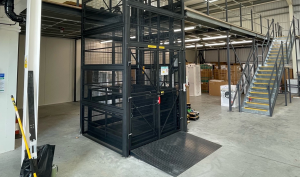
Moving heavy goods between floors doesn’t need to be a bottleneck. Whether it’s a warehouse, mezzanine or custom lift, the right solution improves efficiency, boosts safety, and keeps you compliant. In this chapter, we explore goods lifts, mezzanine lifts, warehouse lifts how they work, where they’re used, and why they’re a smart investment for growing businesses.
What is a Goods lift?
A goods lift is a platform lift designed exclusively for transporting goods only (not people) between different floors in a building. These are commonly used in warehouses, factories, retail spaces and even offices. Goods lifts vary in size, capacity and configuration depending on the load type. Some goods lifts can be designed to allow an attendant to accompany the load however most are built for goods only use.
What is a Warehouse Lift?
A warehouse lift is a lifting system designed to move goods between floors in a warehouse or industrial facility. They help streamline operations by reducing the need for manual lifting, improving efficiency and enhancing safety across multi-level storage environments.
What is a Mezzanine lift?
A mezzanine lift is a specific type of goods lift used to transport goods between the ground floor and a mezzanine floor. Mezzanine lifts are ideal for businesses that have added internal mezzanine floors to expand their storage or working space vertically. They are designed for safe and efficient handling of goods, trolleys or pallets.
Efficiency, safety and regulatory compliance including the Manual Handling Operations Regulations 1992.
A goods lift plays a vital role in boosting operational efficiency, workplace safety and compliance with legal standards. By replacing the manual lifting of heavy or bulky items between floors, goods lifts dramatically reduce the time and effort required for manual lifting – freeing up staff for other productive tasks.
They help minimise the risk of injury from repetitive or strenuous manual handling, a common cause of workplace accidents. This supports businesses compliance with the Manual Handling Operations Regulations 1992, which places a legal responsibility on employers to avoid hazardous manual handling where possible and reduce the risk of injury when it cannot be avoided.
By integrating a well-specified goods lift, businesses can not only improve workflow and reduce downtime but also demonstrate a proactive approach to health and safety.
Common challenges: limited mezzanine access, costly expansions, manual handling risks.
Many businesses face significant challenges when it comes to expanding or streamlining their operations – particularly in facilities with limited space. Rather than facing the high costs and disruption of relocating or renting additional premises, a common and cost-effective solution is to install a mezzanine floor, unlocking unused vertical space and enabling operational growth within the existing building footprint.
Once the mezzanine is in place, it is essential to ensure safe and efficient access. That’s where a mezzanine goods lift comes in. It eliminates the need for manual handling, structural alterations or forklift reliance – providing a faster and safer way to move goods between levels.
By Maximising vertical capacity, businesses can boost productivity, improve site safety and avoid the logistical and financial headaches of moving or extending.
How goods lifts work
Goods lifts operate using a powerful hydraulic system which lifts heavy loads between floors with a smooth controlled motion. The system contains a hydraulic cylinder which raises and lowers the lift platform using pressurised fluid. When the lift is activated, a pump pushes hydraulic fluid into the cylinder, forcing the piston upwards and lifting the platform. To lower, the fluid is gradually released allowing the platform to lower safely and smoothly.
This system is well suited to a variety of applications since hydraulic lifts are known for their high load capacities, low maintenance requirements and quieter operation compared to other lift types.
Hydraulic lifts are also extremely versatile. They can be configured for different travel heights, platform sizes, load types and more, making them ideal for transporting pallets, trolleys and heavy goods.
Safety is built into the system with features like electromechanical interlocks, emergency stops and overload monitors.
Advantages of a goods lift
Installing a goods lift offers a wide range of advantages for businesses looking to improve safety, efficiency and workflow. By simplifying the movement of heavy or bulky items between floors, goods lifts eliminate the need for manual lifting which significantly reduces the risk of workplace injuries and strain.
A goods lift will also help speed up your operation by enabling quicker and easier transport of goods. A 3-person job will turn into 1 and still be quicker, which allows employees to focus on more productive tasks instead.
With various sizes, capacities and customization options available, goods lifts can be tailored to your exact needs – making them a cost-effective solution for long term operational growth.
How many floors can a goods lift travel between?
Goods lifts are designed to be highly versatile and can be configured to serve multiple floors depending on the building layout and the application. Most standard goods lifts can travel between two and six levels. This makes them ideal for transporting goods between ground floors, mezzanines and upper storage or production areas. Goods lifts can also be customised to reach even greater heights. Whether you are moving stock from a warehouse floor to a mezzanine or distributing goods across several building levels, there’s a goods lift that can be tailored to your needs.
How much does a goods lift cost?
The cost of a goods lift can vary depending on several factors, including lift capacity, travel height, platform size, installation requirements and custom features. Prices for a standard goods lift will typically start from around £18,000. While upfront cost is important, investing in the right lift brings long-term savings through improved efficiency, reduced manual handling risks and minimal ongoing maintenance. For an accurate quote, Advanced Handling offer a free, no pressure site survey to recommend the solution for you.
The maximum load capacity of a goods lift
The maximum capacity of a goods lift depends on the model and application. Standard goods lifts typically range from 250kg to 1000kg. However, if your operation involves heavier of bulkier goods, a custom goods lift can be designed to handle the capacity you require, ensuring your goods lift performs effectively for you.

Every business has unique lifting needs. Whether you’re moving lightweight stock, stacked pallets or bulky industrial goods, selecting the right type of goods lift is key to performance and safety. Discover the differences between light, medium and heavy-duty goods lifts to help you understand when a goods only or a goods plus operator model is right for your operation.
Light Duty Goods Lifts
Light duty goods lifts are designed for smaller, less demanding applications. They are ideal for transporting single pallets, boxes, trolleys, bins or lightweight stock between floors.
These lifts are commonly used in retail back-of-house areas, small warehouses, workshops, and production environments where space is limited and goods are relatively light.
Typical specifications include load capacities up to 250kg with platform sizes such as 1,350 x 1,350mm and a travel height of around 4 to 6 meters.
Light duty goods lifts offer a cost effective, space saving solution, often featuring a self-supporting structure, making them quick to install.
Medium Duty Goods Lifts
Medium Duty Goods Lifts are a versatile solution for businesses that need to move heavier loads up to 500kg such as pallets, cages and trolleys across multiple floors. They are Ideal for busy warehouses, manufacturing sites and logistics facilities. Typical specifications include platform sizes from 1,350 – 1,350mm with travel heights from 2,500mm. They are self-supporting with a robust mesh-clad enclosure for added safety and require no pit, making installation easy. With custom configurations available, medium duty goods lifts can be tailored to fit any specific operational need, from platform dimensions and loading patterns to finishes and added safety features.
Heavy Duty Goods Lifts
Heavy Duty Goods Lifts are built for demanding environments where the goods are large and bulky. Designed to handle weights of 1000kg+, they are ideal for use in larger scale warehouses, factories and industrial facilities. A standard heavy-duty lift will have a spacious platform and are engineered for durability and efficiency. As with other models, they are self-supporting with a secure mesh clad enclosure and require no pit. With a wide range of customisation options, these lifts can be tailored to fit your building layout, goods type and operational needs.
Goods only vs Goods plus operator lifts
When choosing a goods lift, it’s important to understand the difference between goods only and goods-attendant models. A goods only lift is designed strictly for transporting items such as pallets, boxes, trolleys and goods between floors without any passengers on the platform. These are ideal for environments where safety protocols and loading areas are already well controlled.
A goods-attendant lift allows for a trained operator to travel with the goods, typically when visibility, handling, or security is required during transit. These lifts include additional safety features such internal controls, communication systems and enhanced interlocks.
Choosing between the two depends on your operational workflow, safety requirements and the nature of the goods being transported.
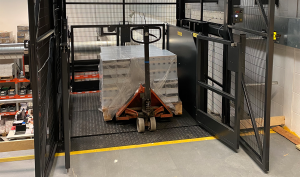
Choosing the right goods lift goes beyond just weight limits, it’s about making sure every element suits your space, load type, workflow and safety requirements. From installation location to door style, finishes, lead times and attendant options, this chapter helps you shape a goods lift specification that’s tailored, compliant and built for the long term.
When selecting the right goods lift for your facility, it is essential to assess your requirements to ensure it meets both your current and future operational needs. Start with the load size and weight capacity, understand what you are lifting. Consider the platform size needed to accommodate your goods, and determine the required lift height based on the number of floors or the height of your mezzanine. It’s also important to determine your loading and unloading directions – whether the lift is positioned for through loading, same side or opposite sides. The lifts location, whether it will be positioned through a floor or on the edge of a mezzanine.
Inside vs outside installation
When planning the location of your goods lift, one key consideration is whether it will be positioned inside your building or outside. An internal installation is ideal for facilities with available floor space and allows for quicker access between levels. It also offers better integration with existing workflows.
An external goods lift is typically enclosed in a weatherproof shaft and can be positioned alongside the building, connecting to mezzanine floors or upper levels via secure doorways. Both options offer the same functionality and safety standards, but the right choice will depend on your building layout, access points and operation. A free site survey can help determine the best location for maximum efficiency and minimal disruption.
Lead times
When planning a goods lift installation, it’s important to factor in lead times to ensure everything aligns with your operational schedule. Most standard goods lifts typically have a lead time of 6 to 8 weeks from order to installation, depending on the model, complexity and any custom features on the lift. Simpler goods lifts such as compact mezzanine lifts tend to fall closer to 6 weeks while bespoke and custom goods lifts may take longer. Once the goods lift is delivered to site, Installation is generally completed within 2 to 3 days, making the overall process relatively quick with minimal disruption. Understanding these time frames early helps avoid delays.
Safety Features, Finishes & Customisation
When specifying a goods lift, it’s important to identify the right safety features, finishes and customisation options to ensure maximum functionality for your specific operation. Standard safety features typically include electromechanical interlocks, emergency stop buttons, overload protection and hazard signage, helping ensure compliance with regulations such as LOLER and PUWER. Many systems can also include advanced options like a remote diagnostics interface, which helps minimise downtime by identifying faults quickly.
In terms of finishes, environments like food production, pharmaceutical facilities, and cleanrooms often require materials that meet strict hygiene and corrosion-resistance standards. In these cases, a stainless steel or galvanised finish is typically recommended, as both offer excellent durability and are easy to clean. For general industrial, warehouse or commercial use, a powder-coated or painted finish is more often sufficient, providing a protective barrier against wear and tear while allowing for visual integration with your facility. Many lift manufacturers also offer a choice of custom paint colors which can align with your brand. Selecting the right finishes ensures the lift not only performs reliably in your environment but also withstands the specific demands of your day-to-day operation.
Assessing the need for a goods + attendant lift
One important consideration when selecting a goods lift is whether an attendant will need to travel with the goods. In most cases, a goods only lift is sufficient, designed solely for transporting items such as pallets, trolleys or roll cases between floors without any passengers. However, in some operations, it may be necessary for a trained operative to accompany the load – particularly in environments where goods need to be monitored during transit or where the lift and stair access are far apart. In these situations, a goods attendant lift may be required, which includes additional safety features such as internal controls, constant pressure buttons, and often emergency communication systems. Deciding whether an attendant is necessary will impact both the design and compliance requirements of the lift, so it’s essential to evaluate your workflow and handling procedures before making a final specification.
Choosing the right door configuration
The type of door configuration on a goods lift plays a key role in how well it fits within your available space and workflow. For sites with limited clearance of tight loading zones, selecting the right door style can help maximise efficiency and safety. Hinged doors are commonly used for straightforward access but require swing clearance which may not be suitable in confined areas.
In tighter spaces, concertina doors are a compact, flexible option that fold neatly to the side.
Roller shutter doors offer a vertical opening mechanism which is ideal where lateral space is restricted.
Bi fold doors provide a middle ground, needing less clearance than a full swing door while offering a wider opening than concertina designs.
For non-standard layouts or unique access needs, bespoke gate configurations can be designed to match specific site constraints. Carefully assessing your building layout and loading/unloading direction will help determine the most effective and space efficient gate style.
Book a Free Site Survey
If you’re unsure about what type of goods lift you need – don’t worry, that’s normal. Every site is different, and that’s why we always recommend booking a free, no-obligation site survey. Our team of experts will visit your premises to understand your layout, lifting needs, operational flow, and talk through the available options in a clear, pressure-free way.
A site visit helps ensure you get a goods lift that’s safe, compliant, and fit for purpose without unnecessary features or added cost. It’s the best way to move forward with confidence.

From UKCA and CE marking to LOLER and PUWER regulations, this chapter outlines the key legal and safety standards every employer or site manager needs to understand. We’ll also cover essential built-in safety features and explain your ongoing duties to stay compliant and protect your team.
UK & EU legal obligations
All goods lifts must comply with relevant UK and EU legislation for workplace equipment. This includes regulations aimed at protecting the safety of employees and visitors when lifting operations are involved. Whether you’re operating under UK law or trading in the European Union, your lift must be designed, installed and maintained in line with these legal frameworks.
UKCA / CE Marking
Depending on where your goods lift is being installed and used, it will need to carry either a UKCA mark (UK Conformity Assessed) or a CE mark (European Conformity). These markings are legally required and serve as proof that the goods lift meets the essential health, safety and environmental protection standards set out in the UK Supply of Machinery (Safety) Regulations 2008 (for UKCA) or the EU Machinery Directive 2006/42/EC (for CE)/
- UKCA marking is mandatory for machinery sold or installed in Great Britain. Read more here
- CE marking is still required for goods being placed on the market in the European Union or Norther Ireland. Read more here
Both markings confirm that the manufacturer has carried out a conformity assesment, produced technical documentation, and issued a Declaration of Conformity. For most goods lifts, this involves internal design checks and third-part assesment if the equipment is considered high risk.
Most manufacturers handle this process in-house, ensuring that your goods lift is fully compliant before installation.
As the buyer or site manager, you should always request a copy of the Declaration of Conformity and confirm the relevant mark on the equipment before use. This guarantees that your goods lift is safe, legally compliant, and ready for operation.
Regulatory Standards
In addition to legal certifications like UKCA or a CE marking, goods lift must comply with a range of technical and safety standards that govern how they’re designed, manufactured and operated. These standards help ensure the lift is safe, reliable and suitable for long term, industrial use.
One key framework is BS EN Standards. For goods lifts, relevant standards include BS-EN 81-31, which sets out safety rules for platform lifts intended for the transportation of goods. These cover critical aspects like load capacity, access points and emergency controls.
You may also encounter references to ISO standards, such as ISO 9001 which focuses on quality management systems. While ISO 9001 is not legally required, many manufacturers will voluntarily become certified to show that they follow consistent processes for design, production and customer service. Choosing a ISO 9001 certified supplier can offer added confidence in product quality and service.
For more information on relevant British goods lift standards, you can visit: https://www.gov.uk/guidance/designated-standards
LOLER & PUWER
Two of the most important regulations for goods lifts in the UK are LOLER and PUWER. These are legal requirements that apply to any business using lifting equipment in the workplace.
LOLER stands for the Lifting Operations and Lifting Equipment Regulations 1998. It requires all lifting equipment to be thoroughly examined by a competent person at regular intervals, usually every 6 or 12 months, depending on the equipment and usage.
These inspections must be properly documented, and any issues must be addressed before the lift is used again. This ensures the goods lift remains safe, legally complaint and fit for use throughout it’s life.
PUWER refers to the Provision and Use of Work Equipment Regulations 1998. This regulation places a duty on employers to ensure that all work equipment, including goods lifts is safe to use, properly maintained, and operated by trained staff. PUWER also covers risk assessments, safety signage, and general use procedures.
Together, LOLER and PUWER form the legal foundation for safe operation and maintenance of goods lifts in the workplace. Choosing a goods lift supplier who can provide LOLWE compliant servicing and PUWER support in house can help ensure your lift is not only installed safely, but remains legally compliant and operational long term.
Read more here
Essential Safety Features
A compliant goods lift must include a range of built-in safety features designed to protect users, prevent accidents and ensure the lift operations within legal technical standards.
These features are not just best practice, they are essential for compliance with LOLER, PUWER & the Machinery Directive.
Key safety components include:
- Hazard and warning stickers: These visual alerts are placed on and around the lift to inform users of key risks, such as pinch points and maximum load limits. They play a crucial role in everyday awareness and help meet PUWER’s requirement for visible safety information.
- Operations manual: Every goods lift should come with a comprehensive manual, detailing correct usage, maintenance procedures and emergency instructions. This is vital for operator training and is often required during safety audits or LOLER examinations.
- Certificate of Conformity: This official document confirms the gods lift complies with all the relevant legislation and standards, including UKCA or CE marking. It’s a legal requirement and should be kept for record keeping and inspections.
- Electromechanical interlocks on gates: These ensure the goods lift cannot be operated unless the gates are closed and locked. They prevent the gates from opening unless the platform is at the correct landing level, helping to avoid falls, and unauthorised access.
- Emergency stop buttons: Positioned at each landing level, these allow operators to immediately stop the lift in case of a fault or emergency. They provide a vital layer of control for preventing injury or equipment damage.
Together, these safety features ensure the lift is not only safe for day-to-today operation, but also meets the regulatory expectations placed on both manufacturers and employers. Bypassing them could result in unsafe conditions, compliance breaches or liability in the event of an accident.
Your Responsibility as an Employer or Site Manager
If you’re the person responsible for ensuring that any lifting equipment on-site is compliant, inspected and used safely. This includes keeping inspection records, arranging LOLER examinations, training staff, and ensuring the goods lift is used only for its intended purpose. Failing to meet these obligations can result in serious legal and safety consequences, so understanding your duties is vital.
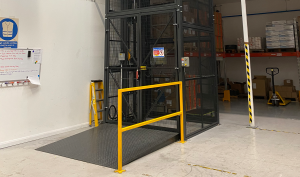
Installing a goods lift might seem complex, but with the right team it’s quick, clean and straightforward. This chapter walks you through a typical installation, from delivery and set up to final testing and hand over, so you know what to expect. With most goods lifts installed in just 1 to 2 days and minimal impact on your site, you’ll be operational in no time .
Installing a goods lift might sound like a big job, but with the right preparation and an experienced team, it’s a fast, smooth and low-disruption process. At Advanced Handling, we’ve designed our installation process to be as efficient and hassle-free as possible. It is typically completed in just 1 to 2 working days, depending on the complexity of the lift and the site.
Minimal disruption
Goods lift installations are designed to fit around your schedule. Our in-house installation engineers are highly experienced and work efficiently to reduce downtime, noise and disruption to your daily operation. Goods lifts are often self-supporting, the installation process avoids major structural work, keeping things neat and simple.
Duration
Most standard goods lifts can be installed and fully operational within 1 to 2 days. For larger, more bespoke goods lifts, the process may be longer.
Day 1 – The first day of installation typically includes:
- Delivery and offloading of the goods lift components
- Positioning and fixing the lift structure into place
- Assembly of the lift shaft, platform gates and framework
- Electrical connections and integration with control systems
- Functional testing of the mechanical operation
- Safety checks on gate interlocks, stop buttons and sensors
By the end of day 1, the structure is usually fully assembled and mechanically complete.
Day 2 – If a second day if needed, it’s generally used for:
- Fine-tuning goods lift alignment and performance.
- Final electrical setup or site-specific programming
- Testing with load simulation and full safety inspection
- Handover, a demonstration of the lift in action.
- Basic operator training and issuing on the operations manual and conformity documentation.
After installation, the goods lift is ready for immediate use, and you will receive full guidance on maintenance, LOLER inspections, and after sales support options.
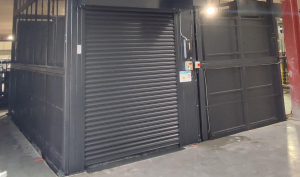
Regular maintenance and inspections are key to extending the lifespan of your goods lift. By following LOLER guidelines and scheduling professional servicing, you can keep your lift safe, efficient and compliant. Access to spare parts and preventative maintenance reduces downtime, prevents costly repairs and ensures your goods lift continues to perform reliably for years to come.
A well-built and properly maintained goods lift is a long-term investment designed to deliver a reliable service for many years. The lifespan of a goods lift will depend on several factors, including usage frequency, environmental conditions and maintenance routines. In some cases, goods lifts have remained in safe operation for over 15 years with minimal component replacement.
This level of durability reflects the importance of quality engineering and regular servicing. Choosing a high-specification goods lift with the right safety features and committing to preventative maintenance reduces the need for major repairs or early replacement.
Routine inspections & Servicing
To maximise the lifespan and ensure compliance with health and safety regulations, it’s important to schedule regular goods lift inspections. This aligns with LOLER 1998 (Lifting Operations and Lifting Equipment Regulations), which mandates regular examination by a competent person, once per year. It is generally recommended that a goods lift is inspected every 6 months to maintain reliability.
Scheduled inspections help to:
- Identify and resolve any minor issues before they escalate.
- Ensure compliance with UKCA/CE regulations.
- Validate safe operation for goods.
- Maintain manufacturer warranty and insurance coverage.
Inspections can be carried out as part of a structured maintenance agreement
Spare parts availability
Access to spare parts is essential for minimising downtime and maintaining long term performance.
Stock is typically available for most goods lifts. Spare parts packages can usually be purchased to ensure key components are available when needed, helping to minimise downtime and extend the life of your equipment. Technical support is often available to help advise on installation, compatibility and maintenance.
How to extend the lifespan of your goods lift: Maintenance and inspection best practices
Ongoing preventative care is the most effective way to prolong the life of a goods lift. Recommended maintenance practices include:
- Weekly visual checks – look for leaks, ware on moving parts and listen out for unusual noises.
- Keep the platform clean and clear – remove debris or unnecessary items that could interfere with sensors or movement.
- Avoid overloading – excessive weight causes long-term mechanical strain.
- Check gate function and interlocks regularly to ensure all safety mechanisms are functioning properly.
- Scheduled professional servicing – lubrication and recalibration of components will protect the systems integrity.
- Maintenance routines can be adapted to suit specific environments from clean rooms to high traffic distribution centers and heavy industrial settings.
Conclusion
With the right approach, a Goods lift can remain a reliable part of your operation for many years. Scheduled inspections, access to spare parts and simple maintenance habits are key to ensuring safety, reducing downtime and getting the most from your investment over time.
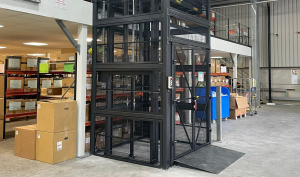
Installing a goods lift in a leased building can be difficult due to restrictions on permanent structural work. Landlords may not approve modifications like cutting into floors or digging pits, and doing so could breach your lease. Freestanding goods lifts offer a low-impact alternative, they require no pits or wall fixings and can be installed directly onto the floor, often with a ramp for easy loading. If you relocate, the goods lift can be dismantled and reinstalled at your next site, giving you long-term flexibility without the hassle.
Installing a goods lift in a leased building often comes with extra challenges. Whether you’re operating from a short-term facility, a shared site, or your restricted by your lease agreement, finding a lifting solution that works without making costly changes to the structure can be a real headache. That’s where modular, free-standing goods lifts offer a clear advantage.
Difficulties with installations in leased buildings
Landlords may be reluctant to approve goods lift installations that involve structural modification. Cutting into floors, adding pits or making major alterations can not only breach your lease terms but also leave you with expensive reinstatement costs at the end of your tenancy.
The value of freestanding goods lifts
Thankfully, many goods lifts are designed to be self-supporting and freestanding, meaning they do not require pits, wall ties or structural anchoring. They sit directly on the ground and can be installed quickly without affecting the building. A ramp can be added to the goods lift for smooth loading and unloading. This allows businesses in leased premises to benefit from vertical goods movement without breaching lease terms.
Relocatable
If you move to another facility, a goods lift can be dismantled and re-installed at your next site, offering flexibility for growing businesses.
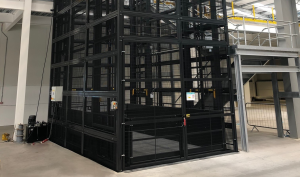
Choosing between a pit-mounted and a pit less goods lift is an important step in planning your installation. A pit less lift with a loading ramp offers fast, low cost setup with minimal disruption, while a pit-mounted lift provides seamless, flush access for high traffic environments. The right choice depends on your building layout, space constraints and daily operational needs, ensuring safe, efficient movement of goods for years to come.
When planning a goods lift installation, choosing between a pit-mounted goods lift or a goods lift with a loading ramp is crucial. Each option has advantages from simple, surface mounted setups to fully integrated systems flush with the floor.
Benefits of a goods lift with a ramp
A pit less goods lift is installed directly on the existing floor surface, eliminating the need for excavation or structural changes. This makes it ideal for leased buildings or sites where digging into the floor isn’t practical or permitted. Because the goods lift sits above ground level, it comes with a loading ramp to bridge the small gap between the floor and platform.
This setup allows fast and low-cost installation, with minimal disruption to your facility. The ramp provides smooth access for pallet trucks and trolleys, ensuring safe and efficient loading. Pit less lifts are also easier to relocate or modify in the future, a big advantage for growing businesses.
When a lift is installed without a pit, a loading ramp ensures easy access for goods on wheels. Ramps are shallow, non-slip and designed for safety and stability. Although the ramp provides excellent functionality, it does require extra space in front of the goods lift, so layout planning is important. In tight or high-traffic environments, this may influence whether a pit installation would be more suitable.
Benefits of a goods lift with a ramp
A pit-mounted goods lift is recessed into the floor, creating a completely flush finish between the lift platform and surrounding surface. This provides seamless, level access with no need for a ramp. It is ideal for high volume operations, warehouses and production lines where equipment moves frequently.
Because the platform sits level with the floor, it offers maximum efficiency and space saving, freeing up the area in front of the goods lift. It also provides a clean, integrated appearance which is especially desirable in new builds, refurbishments or environments that prioritise professional presentation and workflow.
Choosing the right option for your space
Both designs have clear benefits. A pit less goods lift is best for quick installation and minimal disruption, while a pit-mounted goods lift delivers flush access and maximum efficiency. Your choice will depend on the building structure, available space and the type of loads you move day to day.
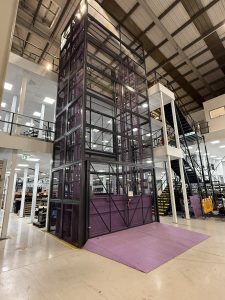
When selecting a goods lift, understanding your operational requirements and environment is key. Every business has unique factors to consider. From loading processes, goods and building layouts to safety standards and long-term plans for expansion. This guide outlines the main options, customisations and upgrades available to help you choose the right configuration for your site.
In-House Design and Custom Solutions
A well-designed goods lift should integrate seamlessly with your building layout and day-to-day workflow. When goods lifts are designed, manufactured, installed and maintained by the same provider, it allows for full flexibility in specification and greater control over performance and compliance.
Lift sizes and dimensions
The main factors that determine the size and configuration of a goods lift include load capacity, platform dimensions and travel height. These elements work together to ensure the lift can safely and efficiently transport materials between levels.
For smaller operations, compact lifts might be more practical. Larger facilities or complex applications may require bespoke designs with specific loading capacities, platform shapes or control options. The goal is to achieve a lift that integrates smoothly into existing processes while maintaining safety and productivity.
Double or twin lift configurations
In facilities with high throughput or multiple loading points, twin lift configurations can provide greater efficiency. This setup involves two independently operated platforms that can run simultaneously or alternately to move goods faster and reduce waiting times.
Each lift can be designed with different load capacities, platform sizes and gate arrangements to suit separate areas of a site. This flexibility helps optimise productivity and ensures the system adapts to varying operational demands without compromising safety or reliability.
To see this type of system in action, read the case study on Regency Glass, which highlights a twin goods lift setup designed to move materials to the mezzanine and return finished goods to the ground floor.
Multi-floor lifting capabilities
Goods lifts and mezzanine lifts can be configured to serve multiple floors to allow easy transportation between the ground, mezzanine and upper levels. Each lift is designed to meet the exact travel height and access requirements of the building, ensuring reliable operation across all levels.
This multi-floor capability is particularly valuable in warehouses, manufacturing plants and retail environments where vertical movement of materials forms a key part in daily operations.
Read about TSL lightings 3-stop goods lift : https://www.advancedhandling.co.uk/case-studies/tsl-lighting-streamlining-heavy-duty-lifting-with-a-3-stop-goods-lift/
Loading pattern options
The way goods are loaded and unloaded from a goods lift directly affects workflow efficiency and safety. Selecting the correct loading pattern helps ensure materials move smoothly through the facility without unnecessary handling or bottlenecks.
Common configurations include:
- Through loading, where goods enter on one side and exit on the opposite side, ideal for continuous flow operations.
- Same-side loading, where goods are both loaded and unloaded from one side, suitable for areas with limited space.
- Opposite-side loading, where access is available from different directions, offering greater flexibility in layout design.
- 90-degree loading, goods enter from one side and exit at a right angle, allowing the lift to fit into corners and tight spaces while maintaining smooth workflow between different production areas.
Choosing the most suitable loading pattern helps improve operational flow and makes the lift safer and more convenient to use.
Finishes and Materials
The finish of a lift plays an important role in both appearance and durability. Powder-coated finishes are available in a wide range or RAL colors, allowing the goods lift to complement it’s surroundings or reflect company branding.
In certain environments, specialist finishes may be required for hygiene, corrosion resistance or longevity. Stainless steel goods lifts are ideal for food processing or clean room areas where hygiene is a priority. Galvanised coatings provide protection in damp or corrosive conditions. Protective classing offers additional durability in busy industrial settings.
Selecting the right materials ensures the lift performs reliably while maintaining a professional appearance over time.
Attachments and Accessories
Custom attachments and accessories can enhance the performance, safety and ease of use of a goods lift. Options such as built in weighing systems allow operators to monitor loads accurately, while tailored control panels provide intuitive operation suited to specific workflows. For busy warehouses, you may opt for keycard access to only allow certain people to use it.
Additional safety features help protect users and ensure smooth loading and unloading at all levels. These upgrades can be specified to match the operational environment, making it easier to adapt the lift to unique site challenges or specialised material handling tasks.
Summary
Selecting the right goods lift involves more than choosing a standard model. Each element from platform size and capacity to finishes, accessories and loading patterns should be carefully considered to meet the specific needs of the site.
A well-planned lift system enhances safety, reduces downtime and integrates efficiently with existing operations, helping businesses move materials more effectively and maintain productivity across all areas of the facility.